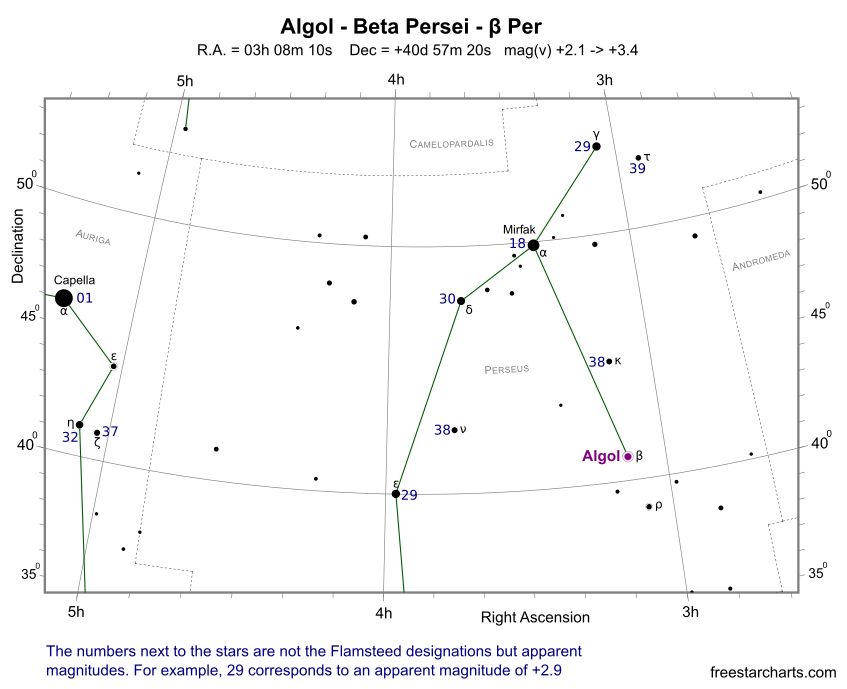Algol is a bright eclipsing binary system located in the northern constellation of Perseus and one of the best-known variable stars in the sky. Often referred to as the "Demon Star", most of the time it shines at magnitude +2.1 but every two days, 20 hours and 49 minutes it suddenly dips in brightness to mag. +3.4, remaining dim for about 10 hours before returning to its original state.

The Algol system consists of at least three stars (β Per A, β Per B and β Per C). The main star is a B8 main sequence star that's nearly 100 times more luminous than the Sun, while the secondary star is a K2 type subgiant 3 times more luminous than our star. These two components are close together with a separation of only 0.062 astronomical units (AU). The third member is a type A5 star, 4 times more luminous than the Sun and located at an average distance of 2.69 AU from the AB pair. The total mass of the system is about 6 Solar masses, with ratios of A, B and C about 3.6 to 0.8 to 1.7 respectively. In addition, spectroscopic analysis indicates there may also be a fourth member.
From our perspective, the orbital plane of Algol A and B is directly in line with the Earth. The regular dips in brightness occur when the dimmer B star moves in front of and eclipses the brighter A star. There is also a secondary eclipse, which occurs when the brighter star occults the fainter secondary resulting in a very small dip in brightness that can be detected with photoelectrical equipment.
The variability of Algol was first recorded by Geminiano Montanari in 1667, although it's likely to have been known for a long time before that. The star was associated with a demon like creature in Greek and Arabic tradition and ancient Egyptians used a calendar of lucky and unlucky days corresponding to its variability period. Although Montanari was the first to record the variability, its periodic nature was not recognized until more than 100 years later. British amateur astronomer, John Goodricke, presented his findings to the Royal Society in May 1783 and even suggested the dimming was caused by a dark body passing in front of the star. In 1889, Algol was finally confirmed as an eclipsing binary when Potsdam astronomer Hermann Carl Vogel made spectroscopic measurements.
Algol is located in Perseus among the stars of the Milky Way. It's positioned west of first magnitude star Capella and southeast of the "W" asterism of Cassiopeia. At it's brightest, Algol is the second brightest star in Perseus, at it's faintest it drops down the list to seventh. The finder chart below shows the position of Algol, along with magnitudes of some surrounding stars for comparative purposes.

Finder Chart for Algol - pdf format (credit:- freestarcharts)
The Algol system is currently located 93 light-years from the Sun, but in the very distant past it was much closer to Earth. About 7.3 million years ago, Algol was only 9.8 light-years away and shone at apparent magnitude of -2.5, more than twice as bright as Sirius appears today.
Algol is a famous variable star in the night sky. It's a popular target since its bright and has a short period of less than 3 days. It also dims quite dramatically and hence the brightness change is obvious to the naked eye. For those new to variable star observing, Algol is an excellent first choice.
Beta Persei (Algol) Data Table
| Name | Beta (β) Persei |
|---|---|
| HD | 19356 |
| HIP | 14576 |
| SAO | 38592 |
| Flamsteed | 26 |
| Constellation | Perseus |
| RA (J2000) | 03h 08m 10s |
| DEC (J2000) | +40d 57m 20s |
| Apparent Mag. (v) | +2.1 -> +3.4 |
| Absolute Mag. | -0.15 |
| Period (days) | 2.86736 |
| Variable Type | Eclipsing binary |
| Distance (light-years) | 93 |
| Mass (Solar) | 3.59 (A) / 0.79 (B) / 1.67 (C) |
| Radius (Solar) | 4.13 (A) / 3.0 (B) / 0.9 (C) |
| Luminosity (Solar) | 98 (A) / 3.4 (B) / 4.1 (C) |
| Spectral Type | B8V (A) / K2IV (B) / A5V (C) |
| Age (years) | < 300 Million |
| Other Designations | Algol, Gorgona, Gorgonea Prima, Demon Star, El Ghoul |